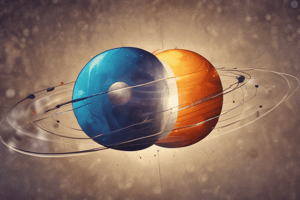Podcast
Questions and Answers
What is the force acting on a object perpendicular to the surface called?
What is the force acting on a object perpendicular to the surface called?
Thrust
What is the SI unit of pressure?
What is the SI unit of pressure?
N/m² or N m⁻²
Which of the following are fluids?
Which of the following are fluids?
- Solids
- Gases
- Both A & B (correct)
- Liquids
Which principle states that an upward force is experienced by a body when it is fully or partially submerged in a fluid?
Which principle states that an upward force is experienced by a body when it is fully or partially submerged in a fluid?
Density of water is the same for all bodies, regardless of their size.
Density of water is the same for all bodies, regardless of their size.
What is relative density?
What is relative density?
The law of gravitation states that the force of attraction between any two objects is proportional to what?
The law of gravitation states that the force of attraction between any two objects is proportional to what?
What is the force of gravitation due to the earth called?
What is the force of gravitation due to the earth called?
The force of gravity increases with altitude.
The force of gravity increases with altitude.
What is the force with which the Earth attracts an object called?
What is the force with which the Earth attracts an object called?
The weight of a body is the same everywhere, but its mass is always larger on the moon.
The weight of a body is the same everywhere, but its mass is always larger on the moon.
What is buoyancy?
What is buoyancy?
Objects with a density lower than that of the liquid in which they're immersed will sink.
Objects with a density lower than that of the liquid in which they're immersed will sink.
What is the name of the principle that describes the upward force experienced by a body submerged in a fluid?
What is the name of the principle that describes the upward force experienced by a body submerged in a fluid?
What is a lactometer used for?
What is a lactometer used for?
The density of a substance changes depending on where it is measured.
The density of a substance changes depending on where it is measured.
Relative density has units.
Relative density has units.
What happens to the force between two objects if the distance between them is halved?
What happens to the force between two objects if the distance between them is halved?
Why does a heavy object not fall faster than a lighter object?
Why does a heavy object not fall faster than a lighter object?
In what direction does the buoyant force on an object immersed in a liquid act?
In what direction does the buoyant force on an object immersed in a liquid act?
Why does a block of plastic, released underwater, come to the surface of the water?
Why does a block of plastic, released underwater, come to the surface of the water?
If the density of a substance is greater than the density of water, it will float in water.
If the density of a substance is greater than the density of water, it will float in water.
What will be the mass of water displaced by a sealed packet with a volume of 350cm³ if the density of water is 1 g/cm³?
What will be the mass of water displaced by a sealed packet with a volume of 350cm³ if the density of water is 1 g/cm³?
Flashcards
Gravitational force
Gravitational force
The force of attraction between any two objects with mass.
Universal Law of Gravitation
Universal Law of Gravitation
Everything attracts everything else with a force that depends on the masses and the distance between them.
Mass
Mass
The amount of matter in an object.
Distance
Distance
Signup and view all the flashcards
Centripetal force
Centripetal force
Signup and view all the flashcards
Circular motion
Circular motion
Signup and view all the flashcards
Velocity
Velocity
Signup and view all the flashcards
Acceleration
Acceleration
Signup and view all the flashcards
Tangent
Tangent
Signup and view all the flashcards
Orbit
Orbit
Signup and view all the flashcards
Object
Object
Signup and view all the flashcards
Newton's Idea
Newton's Idea
Signup and view all the flashcards
Force
Force
Signup and view all the flashcards
Proportional
Proportional
Signup and view all the flashcards
Inversely Proportional
Inversely Proportional
Signup and view all the flashcards
Product
Product
Signup and view all the flashcards
Square
Square
Signup and view all the flashcards
Motion
Motion
Signup and view all the flashcards
Study Notes
Chapter 10: Gravitation
- Gravitation is the force responsible for the motion of objects, planets, and the moon
- A force is needed to change the speed or direction of an object's motion
- Objects dropped from a height fall towards Earth
- Planets orbit the Sun, and the Moon orbits Earth—these motions require a force
- Newton proposed that the same force is responsible for all these motions
- This force is called the gravitational force
- This chapter will delve into gravitation and universal law of gravitation
- Discusses the motion of objects under gravitational force on Earth
- Studies how a body's weight varies from place to place
- Examines conditions for objects to float in liquids
10.1 Gravitation
- The moon orbits the Earth—this implies a force
- Objects thrown upwards return to Earth—this also implies a force
- Newton connected the falling apple with the Moon's orbit
- Concluded that the same force causes both, and all objects attract each other
- This attractive force between objects is called the gravitational force
10.1.1 Universal Law of Gravitation
- Every object in the universe attracts every other object with a force
- This force is proportional to the product of their masses
- This force is inversely proportional to the square of the distance between them
- The force acts along the line joining the centers of the objects
- Formula: F = G * (m1 * m2) / d^2
10.1.2 Importance of the Universal Law of Gravitation
- Explains several interconnected phenomena
- The force that holds us to the Earth
- The Moon's motion around the Earth
- The motion of planets around the Sun
- Tides caused by the Moon and Sun
10.2 Free Fall
- Objects fall towards Earth under the influence of gravitational force
- This acceleration is called acceleration due to gravity (g)
- The magnitude of the velocity of falling objects changes—there is acceleration
- Formula: g = G * M / R^2
- Units: m/s^2
- Objects experience the same acceleration due to gravity, regardless of mass (assuming no air resistance)
- Formulas (uniformly accelerated motion): v = u + at, s = ut + (1/2) at^2, v^2 = u^2 + 2as
10.3 Mass
- Mass is a measure of inertia—resistance to changes in motion
- Mass remains the same regardless of location (Earth, Moon, space)
10.4 Weight
- Weight is the force of attraction exerted by Earth on an object
- Weight is directly proportional to mass and acceleration due to gravity
- Weight = mass * acceleration due to gravity (W=mg)
- Weight varies depending on location
10.4.1 Weight of an Object on the Moon
- The weight of an object on the moon is 1/6 its weight on Earth
- Because of the difference in the mass of Earth and Moon
10.5 Thrust and Pressure
- Thrust is the force acting on an area
- Pressure is the force per unit area (P=F/A)
- Pressure increases with decreasing area for equal force
10.5.1 Pressure in Fluids
- Liquids and gases are fluids
- Fluids also exert pressure on surfaces
10.5.2 Buoyancy
- Buoyancy is the upward force exerted by a fluid on an object
- Objects with density less than that of a fluid will float
- Objects with density more than that of a fluid will sink
- Archimedes' principle: Upward buoyant force is equal to the weight of the displaced fluid
10.6 Archimedes' Principle
- Archimedes explained how buoyant force relates to an object floating in a fluid
10.7 Relative Density
- Relative density is the ratio of the density of a substance to the density of water
- No Unit
Studying That Suits You
Use AI to generate personalized quizzes and flashcards to suit your learning preferences.




